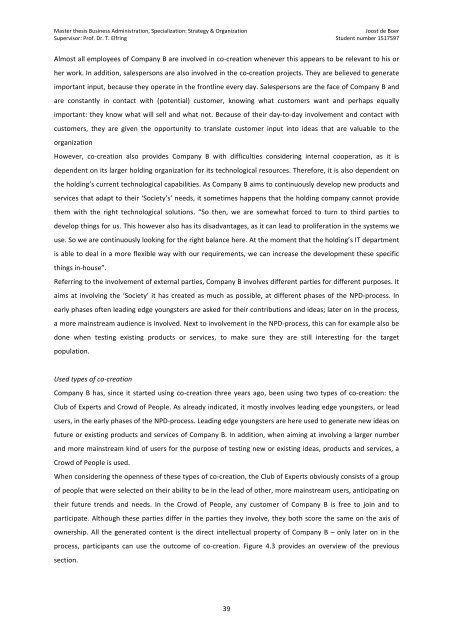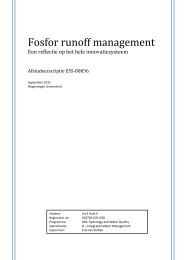Download PDF (English) - Future Ideas
Download PDF (English) - Future Ideas
Download PDF (English) - Future Ideas
Create successful ePaper yourself
Turn your PDF publications into a flip-book with our unique Google optimized e-Paper software.
Master thesis Business Administration, Specialization: Strategy & Organization <br />
Supervisor: Prof. Dr. T. Elfring <br />
Joost de Boer <br />
Student number 1517597 <br />
Almost all employees of Company B are involved in co-‐creation whenever this appears to be relevant to his or <br />
her work. In addition, salespersons are also involved in the co-‐creation projects. They are believed to generate <br />
important input, because they operate in the frontline every day. Salespersons are the face of Company B and <br />
are constantly in contact with (potential) customer, knowing what customers want and perhaps equally <br />
important: they know what will sell and what not. Because of their day-‐to-‐day involvement and contact with <br />
customers, they are given the opportunity to translate customer input into ideas that are valuable to the <br />
organization <br />
However, co-‐creation also provides Company B with difficulties considering internal cooperation, as it is <br />
dependent on its larger holding organization for its technological resources. Therefore, it is also dependent on <br />
the holding’s current technological capabilities. As Company B aims to continuously develop new products and <br />
services that adapt to their ‘Society’s’ needs, it sometimes happens that the holding company cannot provide <br />
them with the right technological solutions. “So then, we are somewhat forced to turn to third parties to <br />
develop things for us. This however also has its disadvantages, as it can lead to proliferation in the systems we <br />
use. So we are continuously looking for the right balance here. At the moment that the holding’s IT department <br />
is able to deal in a more flexible way with our requirements, we can increase the development these specific <br />
things in-‐house”. <br />
Referring to the involvement of external parties, Company B involves different parties for different purposes. It <br />
aims at involving the ‘Society’ it has created as much as possible, at different phases of the NPD-‐process. In <br />
early phases often leading edge youngsters are asked for their contributions and ideas; later on in the process, <br />
a more mainstream audience is involved. Next to involvement in the NPD-‐process, this can for example also be <br />
done when testing existing products or services, to make sure they are still interesting for the target <br />
population. <br />
Used types of co-‐creation <br />
Company B has, since it started using co-‐creation three years ago, been using two types of co-‐creation: the <br />
Club of Experts and Crowd of People. As already indicated, it mostly involves leading edge youngsters, or lead <br />
users, in the early phases of the NPD-‐process. Leading edge youngsters are here used to generate new ideas on <br />
future or existing products and services of Company B. In addition, when aiming at involving a larger number <br />
and more mainstream kind of users for the purpose of testing new or existing ideas, products and services, a <br />
Crowd of People is used. <br />
When considering the openness of these types of co-‐creation, the Club of Experts obviously consists of a group <br />
of people that were selected on their ability to be in the lead of other, more mainstream users, anticipating on <br />
their future trends and needs. In the Crowd of People, any customer of Company B is free to join and to <br />
participate. Although these parties differ in the parties they involve, they both score the same on the axis of <br />
ownership. All the generated content is the direct intellectual property of Company B – only later on in the <br />
process, participants can use the outcome of co-‐creation. Figure 4.3 provides an overview of the previous <br />
section. <br />
39





